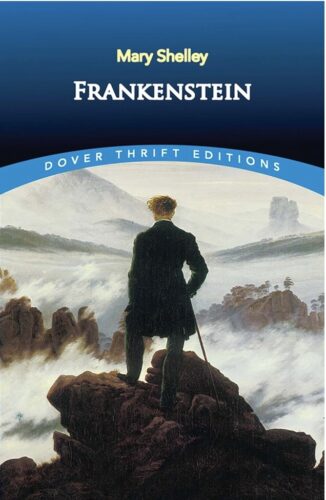Editor’s Note:We are delighted to welcome a guest author to our ‘Literature in the Lymes’ column today and it is none other than the talented daughter of Jennifer Petty Hilger, our regular book reviewer. Campbell Mann is a writer from Lyme, Conn. After training as an operatic mezzo-soprano at The Boston Conservatory, she has since worked as a poet and mixed-media artist. She currently lives in Brooklyn, N.Y., with her partner and a variety of indoor philodendrons.

It is difficult, perhaps impossible, to find a 21st century reader unfamiliar with Frankenstein.
Mary Shelley’s seminal novel, first published in 1818 when its author was 20, has since towered over Gothic and post-Gothic literature for more than two centuries. It is rivaled in magnitude of popular absorption perhaps only by Stoker’s Dracula (a work, which is heavy-laden in its own right with Shelley’s influence, along with that of her husband Percy and the couple’s notorious, occasional friend, the poet Lord Byron).
It has inspired endless and near-constant adaptation—practically every decade of the past century has seen its own half-dozen film and television versions. And while some of these are faithful to the novel, most are wildly extrapolated—the green-skinned, bolt-necked icon of American Halloween bears little resemblance to Shelley’s wretch.
I say this not to argue for literary purism—it is entirely to be expected for a 206-year-old story to be vastly altered in so much time—but merely to highlight our vast distance from the source. Most, while they know Frankenstein, do not know Frankenstein.
Admittedly, Frankenstein can be a difficult text. It possesses many of the qualities that often deter readers from Georgian literature at large; it is verbose, dense, confusing at times in structure and syntax. But in spite of this, it glistens with a modernity that is striking even now. It is gripping, tense, emotionally radiant, and immensely readable. It is haunting and stunningly profound.

As in many 19th century novels, Shelley places us first within the exterior of a frame narrative. We are loosely in the 18th century, as an Arctic-bound research ship finds itself trapped in the ice floes. The expedition’s leader, Captain Robert Walton, begins a series of letters to his sister, Margaret, detailing the strange occurrences of the recent days. First, an enormous figure has been seen driving a pack of sled-dogs in the distance, unnerving the captain and crew. A starving, freezing man is then pulled from the ice, who introduces himself as Victor Frankenstein. In Walton’s eyes, Victor sees a glimpse of something—passion, or obsession—and begins to warn him of its consequences with his own tale.
Born into a wealthy family from Geneva, Switzerland, Victor Frankenstein spends his youth enraptured by the potential power of alchemy and science. Shortly before he leaves to pursue his interests formally at the University of Ingolstadt, his mother dies, pushing his obsession deeper into the mysterious forces of life and death.
At Ingolstadt he excels and soon longs to further his own secret theories, body-snatching corpses and vivisecting feral animals until he has created an eight-foot-tall humanoid creature, whom Shelley calls the wretch. But naturally, Victor has not thought this through. As the wretch gurgles painfully to unnatural life, his creator abandons him and flees in terror.
The narrative’s long remainder details the ways in which Victor and the wretch relate to the world and one another. Of course, it is far more complicated than that, but that is the most broad stroke of it. There is violence, loss, and pain on all fronts.
Shelley tells us, over and over in endless ways, that these two beings are inextricably bound to one another. What do we owe to our children? What do we owe to each other, and to ourselves? What if our actions are not the whim of a moment but profound and material choices, with consequences borne not by us alone?
Mary Shelley wants to know as well.